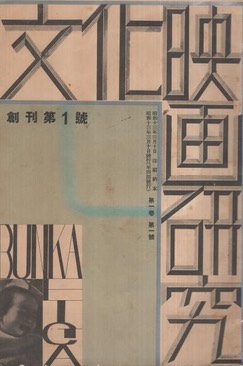Bunka eiga kenkyu, the third in my series of reprints of prewar film studies/film theory journals at Yumani Shobo, has been published. This follows the reprints of Eiga kagaku kenkyu (see my introduction here) and Eiga geijutsu kenkyu (see my introduction here).

Bunka eiga kenkyu is a bit closer to Eiga kagaku kenkyu than to Eiga geijutsu kenkyu in that it is less a film theory journal, like the latter, than a periodical by filmmakers attempting to understand their art and practice. It was actually not my first choice to do for the third reprint. The plan was to do Eiga zuihitsu, the legendary coterie magazine published in Kyoto in the late 1920s that was core to what Makino Mamoru later called the Kyoto Eiga Gakuha. But that journal is so rare, Yumani could not gather enough original issues to serve as the basis for the reprint. So I was asked to identify a substitute and had to do it quickly. I picked Bunka eiga kenkyu because, of the prewar journals that had not been reprinted and that could be reprinted without too much difficulty, it was probably the most consequential, especially in the field of documentary and debates about film realism. Yumani insisted we had to keep to the same timeline, so that did not leave much time for me to prepare materials and write a commentary. We also found out that Makino had been in discussions with another publisher about reprinting Bunka eiga kenkyu, although that publisher had done little to bring the plan to fruition. We got the okay to reprint the journal, and I asked two of the young scholars who were helping Makino’s project, Sato Yo and Morita Noriko, to collaborate by writing commentaries. So unlike the first two reprints, which just included my commentary, this one sports three. In the end, we dedicated the reprint to Makino Mamoru.
Here is the blurb I wrote for the publicity catalog:
From the mid-1930s, the so-called “culture film” became central to the Japanese film world. On the one hand, these documentary films, borrowing their name from the German “kulturfilm,” became the contact zone between cinema and politics, between cinema and the state. Given that the screening of culture films were required in theaters after the implementation of the Film Law, they undoubtedly bore a considerable role in the media strategy of war mobilization. At the same time in the film critical world, the argument that the essence of film was less to create fiction than to record reality came to prominence at the time, and so culture films were spotlighted as bearing the future possibilities of cinema.
It was Bunka eiga kenkyu, published between March 1938 and December 1940, that became one of the key forums for debating culture films, those contradictory entities that could be seen as state propaganda or as documents of reality depending on the perspective. It was a periodical associated with Geijutsu Eigasha, a production company founded by Omura Einosuke in 1935, but Bunka eiga kenkyu did not just introduce films like Snow Country and Record of a Nursery that were made by GES (as it was called). Well-known filmmakers in the culture film world, ranging from Tsuburaya Eiji and Atsugi Taka to Ishimoto Tokichi and Ogiwara Tai, wrote about a wide-range of topics surrounding bunka eiga broadly understood—including documentary and animation—including the films of other companies and contemporary issues in cinematography, sound recording, and exhibition. It also became a location for debates over the implementation of the Film Law and the relationship between state bureaucrats and those shooting films. The journal also sponsored roundtable discussions on such topics as film and agriculture, including authors like Wada Tsuto, Yarita Ken’ichi, and Fujimori Seikichi, or music and cinema, with composers such as Hayasaka Fumio, Fukai Shiro, and Hattori Tadashi participating.
On the pages of Bunka eiga kenkyu, which featured pieces by many veterans of the proletarian culture movement, discussions about the essence as well as social and cultural importance of cinema stood out. Beyond introductions to foreign film discourse, there were debates about not just culture film, but also about the nature of cinema, particularly its realism, by both cultural critics such as Yanagita Kunio, Sata Ineko, Murayama Tomoyoshi, Sasaki Kiichi, and Miura Tsutomu, as well as prominent film critics like Tsumura Hideo, Ueno Kozo, and Sekino Yoshio. The level of debate was consistently high, with the the Lupe Debate, arguably the most famous prewar debate on cinema occurring between Kamei Fumio and Miki Shigeru, ultimately raising questions about the ethics of cinema.
Bunka eiga kenkyu may seem to appear somewhat prosaic, but it in fact is an important magazine that reflects the era and its media.
For the commentaries, Sato Yo wrote about the journal in relation to newsreel movie theaters, Morita Noriko discussed it in relation to Geijutsu Eigasha, and I use the Lupe Debate to consider the periodical’s relation to shifts in film theory at the time.
The reprint includes all the issues produced of the journal, compiled in five volumes. As with many reprints, it is expensive (about $900), and is not produced with purchase by individuals in mind. The publication is aimed at libraries, and I hope as many can purchase it as possible. We sold enough of the previous reprints that Yumani okayed the next one, so I hope the series can continue.
Here is the bibliographic data and links to information on the reprint:
- Bunka eiga kenkyu / 文化映画研究. 5 vols. Yumani Shobo, 2021. ISBN 978-4-8433-6093-4
- Yumani Shobo page for the reprint. Includes a link to a PDF of the publicity pamphlet.

